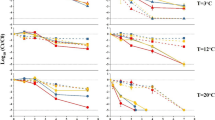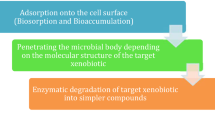Abstract
A pond mesocosm study was conducted in a central Minnesota wetland to evaluate the potential toxicity of the microbially-derived insecticide Bacillus thuringiensis var. israelensis (B.t.i.) to chironomids. B.t.i. was applied as VectoBac® G to mesocosms on two occasions (21 d apart) at five rates (0.3X, 1X, 2.5X, 5X, 10X) with three replicate mesocosms per rate. The 1X rate (9 kg/ha) was that operationally used by the Minneapolis-St. Paul Metropolitan Mosquito Control District for early summer mosquito control. Chironomid abundances following B.t.i. treatment were compared to abundances in untreated control mesocosms. The abundance of Chironomidae larvae was significantly reduced at the 10X treatment 4 d after the first B.t.i. application. Chironomid abundance was also reduced after the second application with 10X, but showed strong signs of recovery within 32 d. Chironominae, the numerically dominant subfamily within the Chironomidae, showed a similar response. The abundance of Orthocladiinae larvae was significantly reduced at both the 10X and 5X treatments, whereas the Tanypodinae appeared unaffected by all B.t.i. treatments. Of the two tribes comprising the Chironominae, the Chironomini displayed a response very similar to that of its parent subfamily, although reductions in abundance were not statistically significant. The tribe was dominated by Dicrotendipes, Einfeldia, and Endochironomus, none of which were significantly reduced following either 10X application. The second tribe, the Tanytarsini, were slightly more susceptible to B.t.i. than the Chironomini, displaying significant reductions in abundance after both 10X applications. The Tanytarsini were dominated by Paratanytarsus, which were reduced by 91% 4 d after both 10X B.t.i. applications. Tanytarsini and Chironomini were also reduced in abundance (by 83 and 75%, respectively) at the 5X treatment, but reductions were not statistically significant. Regressions of larval chironomid abundance versus B.t.i. treatment rate indicated that the B.t.i. rates required to reduce chironomid abundance by 25, 50, and 75% were 1.5–2.0X, 2.1–3.3X, and 3.5–11.0X, respectively. Emergence of adult Chironomidae was significantly reduced at the 10X B.t.i. treatment, but not at 5X. The same trend was observed for the Chironominae, which comprised 82% of the family, but not for Orthocladiinae and Tanypodinae. Emergence of Ceratopogonidae and Chaoboridae was unaffected by all B.t.i. treatments.
Similar content being viewed by others
References
Ali, A. (1981) Bacillus thuringiensis serovar israelensis (ABG-6108) against Chironomids and some nontarget aquatic invertebrates. J. Invertebr. Pathol. 38, 264–72.
Ali, A., Baggs, R.D. and Stewart, J.P. (1981) Susceptibility of some Florida chironomids and mosquitoes to various formulations of Bacillus thuringiensis serovar. israelensis. J. Econ. Entomol. 74, 672–7.
Back, C., Boisvert, J., Lacoursiere, J.O. and Charpentier, G. (1985) High-dosage treatment of a Quebec stream with Bacillus thuringiensis serovar. israelensis: efficacy against black fly larvae (Diptera: Simuliidae) and impact on non-target insects. Can. Entomol. 117, 1523–34.
Charbonneau, C.S., Drobney, R.D. and Rabeni, C.F. (1994) Effects of Bacillus thuringiensis var. israelensis on nontarget benthic organisms in a lentic habitat and factors affecting the efficacy of the larvicide. Environ. Toxicol. Chem. 13, 267–79.
Chilcott, C.N., Knowles, B.H., Ellar, D.J. and Drobniewski, F.A. (1990) Mechanisms of action of Bacillus thuringiensis israelensis parasporal body. In H. de Barjac and D.J. Sutherland, eds., Bacterial Control of Mosquitoes and Blackflies: Biochemistry, Genetics & Applications of Bacillus thuringiensis israelensis and Bacillus sphaericus. New Brunswick, NJ: Rutgers University, pp. 45–65.
Cilek, J.E. and Knapp, F.W. (1992) Distribution and control of Chironomus riparius (Diptera: Chironomidae) in a polluted creek. J. Amer. Mosquito Control Assoc. 8, 181–3.
Clarke III, J.L. and Rowley, W.A. (1984) Evaluation of granular Bacillus thuringiensis var. israelensis (Serotype H-14) formulations against mosquito larvae in central Iowa. Mosquito News 44, 502–5.
Federici, B.A., Lüthy, P. and Ibarra, J.E. (1990) Parasporal body of Bacillus thuringiensis israelensis: Structure, protein composition, and toxicity. In H. de Barjac and D.J. Sutherland, eds., Bacterial Control of Mosquitoes and Blackflies: Biochemistry, Genetics & Applications of Bacillus thuringiensis israelensis and Bacillus sphaericus. New Brunswick, NJ: Rutgers University, pp. 16–44.
Garcia, R., Des Rochers, B. and Tozer, W. (1980) Studies on the toxicity of Bacillus thuringiensis var. israelensis against organisms found in association with mosquito larvae. Proceedings, California Mosquito and Vector Control Association, Fresno, CA. 48, 33–6.
Hamilton, M.A., Russo, R.C., and Thurston, R.V. (1977) Trimmed Spearman-Karber method for estimating median lethal concentrations in toxicity bioassays. Environ. Sci. Technol. 11, 714–719. Correction 12: 417.
Ignoffo, C.M., Garcia, C., Kroha, M.J., Fukuda, T. and Couch, T.L. (1981) Laboratory tests to evaluate the potential efficacy of Bacillus thuringiensis var. israelensis for use against mosquitos. Mosquito News 41, 85–93.
Jackson, J.K., Sweeney, B.W., Bott, T.L., Newbold, J.D. and Kaplan L.A. (1994) Transport of Bacillus thuringiensis var. israelensis and its effect on drift and benthic densities of nontarget macroinvertebrates in the Susquehanna River, northern Pennsylvania. Can. J. Fish. Aquat. Sci. 51, 295–314.
Jandel Corporation. (1995) SigmaStat®, Version 2.01. Jandel Corporation, San Rafael, CA, USA.
Lambert, B. and Peferoen, M. (1992) Insecticidal promise of Bacillus thuringiensis: facts and mysteries about a successful biopesticide. BioScience 42, 112–23.
Liber, K., Schmude, K.L. and Corry, T.D. (1996) Effects of the insect growth regulator diflubenzuron on insect emergence within littoral enclosures. Environ. Entomol. 25, 17–24.
Merritt, R.W., Walker, E.D., Wilzbach, M.A., Cummins, K.W. and Morgan, W.T. (1989) A broad evaluation of B.t.i. for black fly (Diptera: Simuliidae) control in a Michigan river: efficacy, carry and nontarget effects on invertebrates and fish. J. Amer. Mosquito Control Assoc. 5, 397–415.
Miura, T., Takahashi, R.M. and Mulligan III, F.S. (1980) Effects of the bacterial mosquito larvicide, Bacillus thuringiensis serotype H-14 on selected aquatic organisms. Mosquito News 40, 619–22.
Merritt, R.W. and Cummins, K.W. (eds). (1995) An Introduction to the Aquatic Insects of North America. Third Edition. Dubuque, IA: Kendall/Hunt Publishing Co.
Molloy, D.P. (1992) Impact of the black fly (Diptera: Simuliidae) control agent Bacillus thuringiensis var. israelensis on chironomids (Diptera: Chironomidae) and other nontarget insects: results of ten field trials. J. Amer. Mosquito Control Assoc. 8, 24–31.
Mulla, M.S. (1990) Activity, field efficacy, and use of Bacillus thuringiensis israelensis against mosquitoes. In H. de Barjac and D.J. Sutherland, eds., Bacterial Control of Mosquitoes and Blackflies: Biochemistry, Genetics & Applications of Bacillus thuringiensis israelensis and Bacillus sphaericus. New Brunswick, NJ: Rutgers University, pp. 134–60.
Mulligan III, F.S., Schaefer, C.H. and Wilder, W.H. (1980) Efficacy and persistence of Bacillus sphaericus and B. thuringiensis H. 14 against mosquitoes under laboratory and field conditions. J. Econ. Entomol. 73, 684–8.
Niemi, G.J., Axler, R.P., Hanowski, J.M., Hershey, A.E., Lima, A., Regal, R.R. and Shannon, L.J. (1995) Evaluation of the potential effects of methoprene and Bti (Bacillus thuringiensis israelensis) on wetland birds and invertebrates in Wright County, MN, 1988 to 1993. Report #143, Natural Resources Research Institute, University of Minnesota, Duluth, MN.
Priest, F.G. (1992) A review: biological control of mosquitoes and other biting flies by Bacillus sphaericus and Bacillus thuringiensis. J. Appl. Bacteriol. 72, 357–69.
Schmude, K.L., Liber, K., Corry, T.D. and Stay, F.S. (1999) Effects of 4-nonylphenol on benthic macroinvertebrates and insect emergence in littoral enclosures. Environ. Toxicol. Chem. (in press).
Simmons, K.R. (1991) Effects of multiple applications of the bacterial insecticide, Bacillus thuringiensis var. israelensis (Bti) on black flies and non-target invertebrates in the Mississippi River: results of 1989 studies. Metropolitan Mosquito Control District, St. Paul, MN.
Wipfli, M.S. and Merritt, R.W. (1994) Effects of Bacillus thuringiensis var. israelensis on nontarget benthic insects through direct and indirect exposure. J. N. Amer. Benthol. Soc. 13, 190–205.
Wiederholm, T. (ed.). (1983) Chironomidae of the Holarctic region: keys and diagnoses. Part 1. Larvae. Entomologica Scandinavica Supplement 19, 1–457.
Wiederholm, T. (ed.). (1989) Chironomidae of the Holarctic region: keys and diagnoses. Part 3. Adult males. Entomologica Scandinavica Supplement 34, 1–532.
Author information
Authors and Affiliations
Rights and permissions
About this article
Cite this article
Liber, K., Schmude, K.L. & Rau, D.M. Toxicity of Bacillus thuringiensis var. Israelensis to Chironomids in Pond Mesocosms. Ecotoxicology 7, 343–354 (1998). https://doi.org/10.1023/A:1008867815244
Issue Date:
DOI: https://doi.org/10.1023/A:1008867815244




